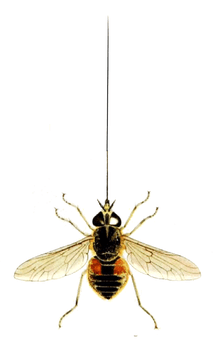Philoliche longirostris
Philoliche longirostris is a fly of the Tabanidae family that is found in India, Nepal[1] specifically the Himalayas.[2] It was first described and given a binomial name by Thomas Hardwicke in 1823.[3] Notable is its proboscis, which is "many times longer than its body".[2]
| Philoliche longirostris | |
|---|---|
 | |
| Scientific classification | |
| Kingdom: | |
| Phylum: | |
| Class: | |
| Order: | |
| Family: | |
| Genus: | |
| Species: | P. longirostris |
| Binomial name | |
| Philoliche longirostris (Hardwicke, 1823) | |
| Synonyms | |
|
Pangonia longirostris | |
Males and females feed on nectar using the long mouthparts formed by the prementum of the labium. Females, in addition, feed on blood using the mandibular and maxillary structures which are much shorter.[4]
References
- Wood, John George (1874). Insects abroad: Being a popular account of foreign insects, their structure, habits, and transformations. Longmans, Green and Co. pp. 751–52.
- Allbutt, Thomas Clifford (1907). A System of medicine. 2. Macmillan. p. 178.
- Evenhuis, N.L. (1989). Catalog of the Diptera of the Australasian and Oceanian regions. 86. Apollo Books. p. 281. ISBN 978-0-930897-37-6.
- Karolyi, Florian; Colville, Jonathan F.; Handschuh, Stephan; Metscher, Brian D.; Krenn, Harald W. (2014). "One proboscis, two tasks: Adaptations to blood-feeding and nectar-extracting in long-proboscid horse flies (Tabanidae, Philoliche)". Arthropod Structure & Development. 43 (5): 403–413. doi:10.1016/j.asd.2014.07.003. PMC 4175409. PMID 25066540.
This article is issued from Wikipedia. The text is licensed under Creative Commons - Attribution - Sharealike. Additional terms may apply for the media files.